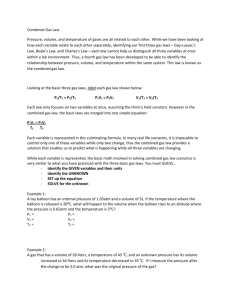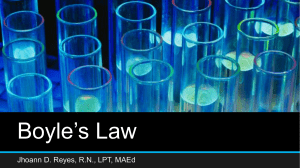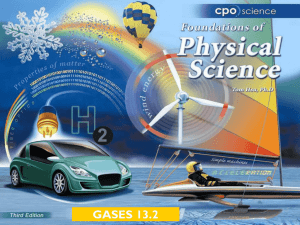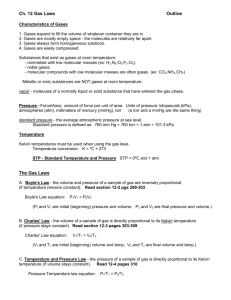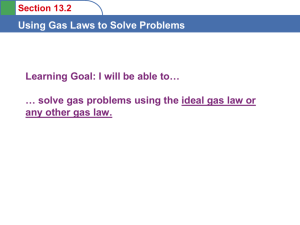The Gas Laws
advertisement
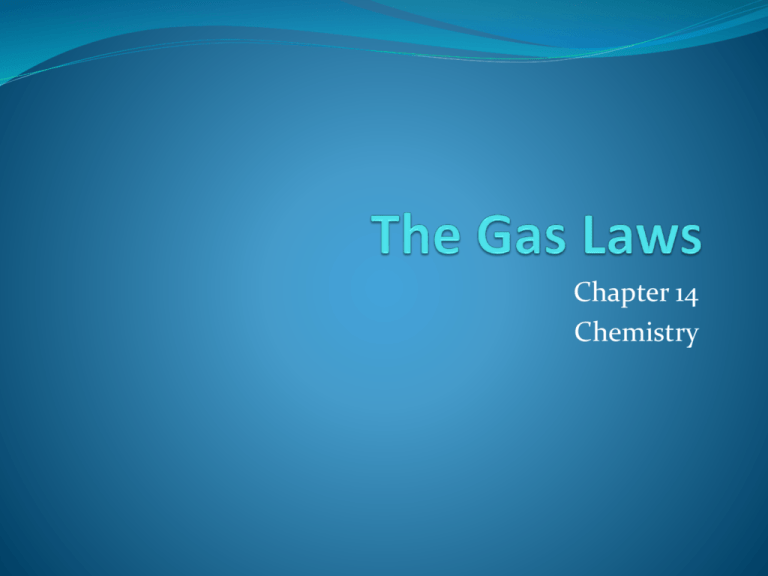
Chapter 14 Chemistry Remember gases behave differently Gases are affected by Temperature Pressure Volume Boyle’s Law Robert Boyle Relationship between pressure and volume P1V1 = P2V2 Inverse relationship – As volume decreases, pressure increases Example Problem A sample of helium gas in a balloon is compressed from 4.0 L to 2.5 L at a constant temperature. If the pressure of the gas in the 4.0 L volume is 210 kPa, what will the pressure be at 2.5 L? P1V1 = P2V2 Boyle’s Law Activity Marshmallow in Syringe Dalton’s Law of Partial Pressures Charles’s Law Jacques Charles Relationship between temperature and pressure Direct Relationship V1 = V2 T1 T2 Sample Problem A gas sample at 40.0oC occupies a volume of 2.32 L. If the temperature is raised to 75oC, what will the volume be, assuming the pressure remains constant? Charles’s Law Activity Cold Balloon Bottle Crush Popcorn Gay-Lussac’s Law Relationship between temperature and pressure Volume must be held constant Direct relationship P1 = P2 T1 T2 Sample Problem The pressure of a gas in a tank is 3.2 atm at 22.o oC. If the temperature rises to 60 oC, what will be the gas pressure in the tank? Combined Gas Law P1V1 = P2V2 T1 T2 Sample Problem A gas at 110 kPa and 30.o oC fills a flexible container with an initial volume of 2.oL . If the temperature is raised to 80oC and the pressure increased to 440 kPa, what is the new volume? Avagadro’s Principle Equal volumes of gases at the same temperature and pressure contain equal numbers of particles Molar volume = the volume one mole of gas occupies at 0oC and 1.0 atm pressure One mole of any gas will occupy 22.4L Practice Problem Calculate the volume that 2.0 Kg of methane gas (CH4) will occupy at STP Ideal Gas Law Ideal gases have almost no volume and the particles are far enough apart to not exert any type of repulsive or attractive force on another particle. Do not exist in real world, but most gases behave like ideal gases at STP PV=nRT Practice Calculate the number of moles of gas contained in a 3.0L vessel at 3.00 x 102 K with a pressure of 1.5 atm PV = nRT P = 1.5 atm V = 3.0L R = .0821 T = 3oo K N=? Gas Stoichiometry Remember, coefficients represent the number of moles of a reactant or product 2 C4H10 + 13 O2 8 CO2 + 10 H2O Calculations involving only volume CH4 + 2 O2 CO2 + 2H2O It takes 2 liters of oxygen to react with 1 L of methane to produce 1 liter of carbon dioxide and 2 liters of water Volume to volume problem What volume of oxygen gas is needed for the complete combustion of 4.0 L of propane gas (C3H8)? Assume constant pressure and temperature. C3H8 + 5O2 3CO2 + 4H2O Start with what you know: 4.0L C3H8 2. What is the ratio of Oxygen to propane? 5 oxygen 1 propane 3. Multiply the amount of propane by the ratio to get oxygen 5 x 4 = 20 L 1. Volume to Mass Problem Ammonia is synthesized from hydrogen and nitrogen gases. N2 + 3H2 2 NH3 If 5.00 L of nitrogen reacts completely by this reaction at a constant pressure and temperature of 3.00atm and 298K, how many grams of ammonia are produced? 1. Analyze problem (V, P, T, ) 2. Solve for unknown Determine volume ratio Use ratio to determine liters of ammonia produced Rearrange and use ideal gas law to solve for n (use liters of ammonia produced as V) 3. Convert moles of ammonia to grams of ammonia
